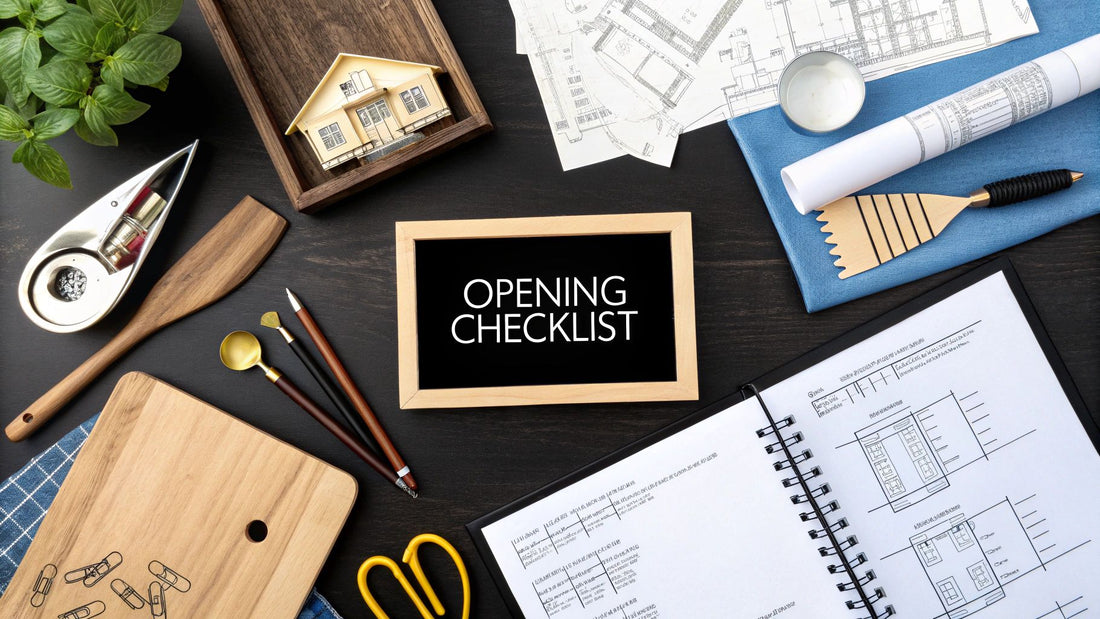
4 Must-Know Tips in Our Checklist for Restaurant Opening
Share
Launching a restaurant is a monumental undertaking, blending culinary passion with sharp business acumen. This comprehensive guide serves as your end-to-end roadmap, transforming your vision into a thriving reality. We've compiled the ultimate checklist for restaurant opening, breaking down the complex process into seven manageable, actionable stages. This is not just a list; it is a strategic blueprint designed to prevent costly oversights and streamline your path to launch.
Each section provides a detailed framework for critical operational areas, from navigating the maze of legal compliance and permits to designing a hyper-efficient kitchen layout. We will delve into crafting a profitable menu, recruiting and training a stellar team, and establishing a resilient supply chain. Our focus is on practical implementation, ensuring you have the tools to manage your finances, select the right POS system, and build a powerful brand that resonates with customers.
Key Takeaway: This checklist is designed to be your single source of truth, helping you stay organized, make informed decisions, and avoid common pitfalls that can derail a new restaurant before its doors even open.
Throughout this guide, we will also equip you with insights on how to stay informed about critical industry trends and discover exclusive deals on the latest restaurant equipment and supplies. By following this structured approach, you will be prepared to not only open your doors but to build a lasting and profitable business. Let’s start laying the foundation for your grand opening.
1. Legal Compliance and Permits
Navigating the web of legal requirements is the non-negotiable first step in any successful restaurant launch. This foundational phase involves securing all necessary documentation, permits, and licenses to operate legally. Overlooking even a single requirement can lead to severe consequences, including hefty fines, forced closures, and a damaged reputation before you even serve your first customer. Think of legal compliance not as a hurdle, but as the bedrock upon which your entire business is built. This is a critical part of your checklist for restaurant opening that protects your investment and ensures long-term viability.
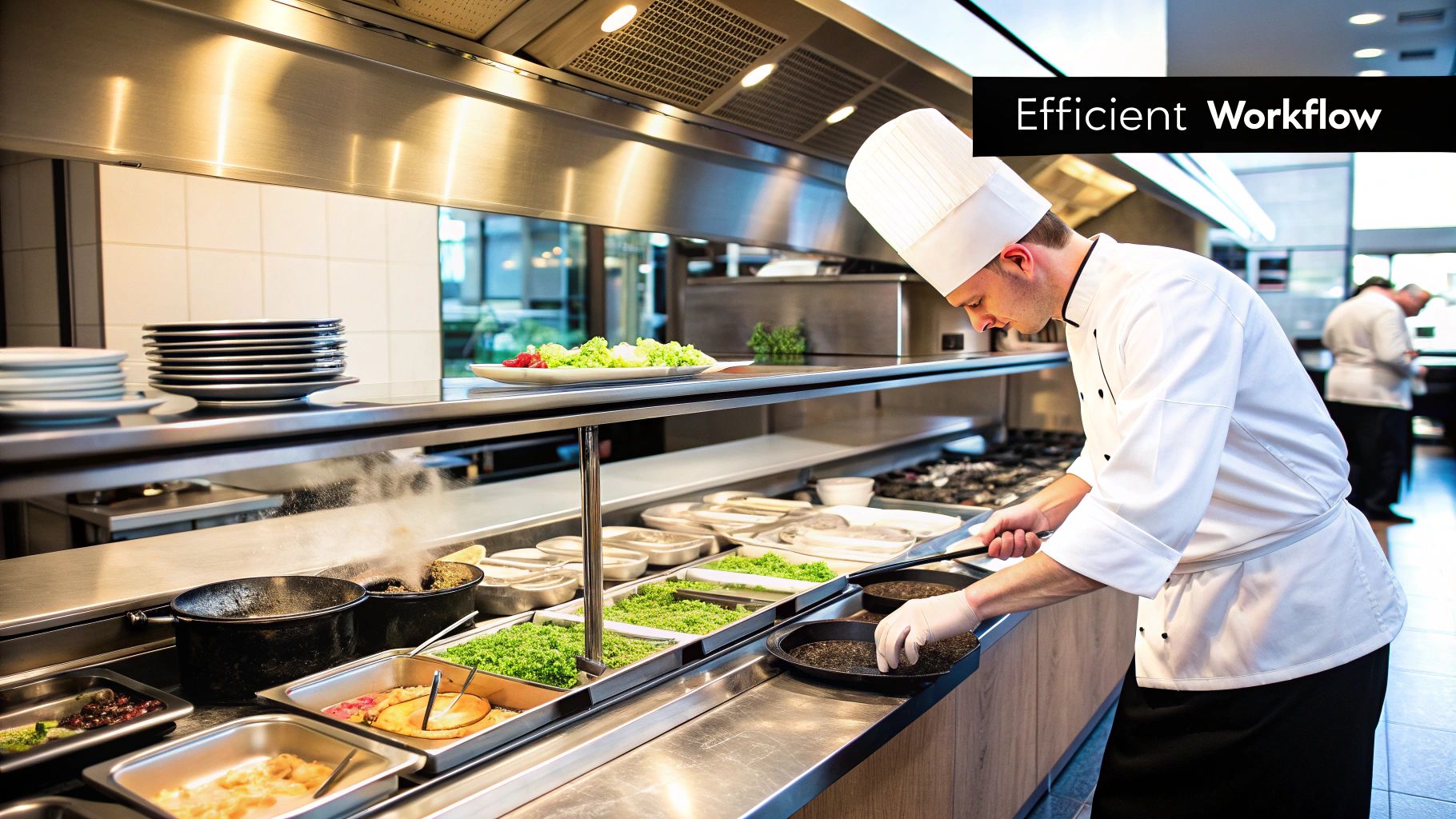
This process involves a multi-layered approach, as regulations exist at the federal, state, and local levels. For instance, while you'll need a federal Employer Identification Number (EIN) to hire staff, your city’s health department will issue the food service permit that allows you to handle and sell food. Major chains like Shake Shack exemplify meticulous compliance, dedicating teams to navigate the unique zoning and permit landscape of each new city they enter, ensuring a smooth and legally sound opening every time.
Key Documents You'll Likely Need:
- Business License: The fundamental license to operate a business in your city or county.
- Food Service License: Issued by your local health department after an inspection, this certifies your establishment meets sanitation standards for storing, preparing, and serving food.
- Employer Identification Number (EIN): A federal tax ID number required if you plan to hire employees.
- Certificate of Occupancy: Confirms your building is safe for public use and complies with all building and zoning codes.
- Liquor License: If you plan to serve alcohol, this is often the most time-consuming and expensive permit to obtain. The process varies drastically by state and even county.
Actionable Tips for a Smooth Process:
Successfully managing legal compliance requires foresight and organization. Use these strategies to stay ahead of the curve.
- Start Early: Begin the application process at least 3 to 6 months before your target opening date. Liquor licenses, in particular, can have long waiting periods or lottery systems.
- Hire Local Expertise: Engage a lawyer or consultant who specializes in local restaurant compliance. Their familiarity with municipal codes and relationships with local agencies can be invaluable.
- Create a Master Checklist: Develop a spreadsheet that tracks every required permit, its application deadline, associated fees, renewal date, and contact person.
- Build Agency Relationships: Introduce yourself to your local health and fire inspectors early on. A cooperative, professional relationship can make inspections smoother and provide you with a resource for questions. Keep all approved documents in an organized binder, both physically and digitally, for easy access during inspections.
2. Kitchen Equipment and Layout Design
The kitchen is the engine of your restaurant, and its design dictates the speed, efficiency, and quality of your entire operation. Planning your kitchen equipment and layout is a foundational step that directly impacts workflow, safety, and profitability. A well-designed kitchen minimizes staff movement, reduces ticket times, and ensures food is prepared consistently and safely. This is a crucial element of any checklist for restaurant opening because a poorly planned kitchen can create operational bottlenecks, drive up labor costs, and hinder your ability to scale.
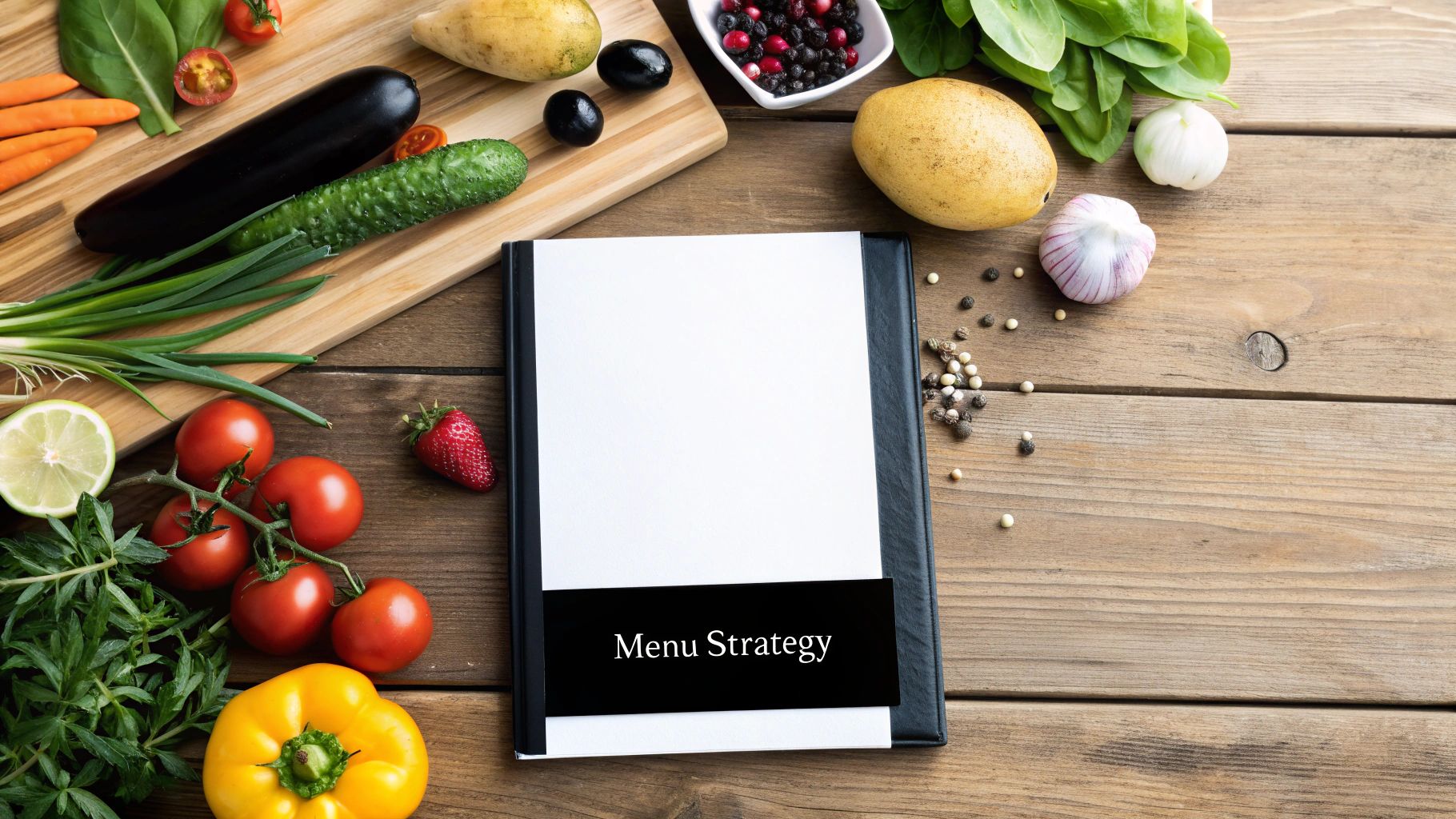
This process goes far beyond simply buying cooktops and refrigerators; it involves strategically mapping out every station, from receiving and storage to prep, cooking, and dishwashing. Iconic brands like McDonald's, pioneered by Ray Kroc, built empires on hyper-efficient, standardized kitchen layouts that ensure a consistent product anywhere in the world. Similarly, modern fast-casual leaders like Sweetgreen use an assembly-line design to facilitate rapid, customizable meal preparation, demonstrating how layout directly serves the brand's promise. A thoughtful design is your first line of defense against chaos during a busy service.
Key Equipment Categories to Plan For:
- Cooking Equipment: Ovens, ranges, fryers, griddles, and grills tailored to your specific menu items.
- Refrigeration: Walk-in coolers, freezers, and under-counter refrigerators to meet food safety and inventory needs.
- Food Preparation: Stainless steel prep tables, mixers, slicers, food processors, and cutting boards.
- Storage: Dry storage shelving, ingredient bins, and dunnage racks to keep inventory organized and off the floor.
- Dishwashing: A commercial-grade three-compartment sink, a high-temperature dishwasher, and drying racks to maintain sanitation standards.
Actionable Tips for a Smooth Process:
A functional kitchen is designed, not improvised. Use these strategies to build an efficient operational core for your restaurant.
- Hire a Professional: Engage a kitchen designer or a consultant from a firm like those in the Foodservice Consultants Society International (FCSI). Their expertise can prevent costly mistakes in workflow and code compliance.
- Prioritize Workflow: Design your layout around the natural progression of food, from the delivery door to the customer's plate. This minimizes cross-contamination risks and reduces staff steps.
- Choose Energy-Efficient Models: While the initial cost may be higher, ENERGY STAR® rated equipment will significantly reduce your utility bills over the long term. Staying informed on the latest equipment trends and exclusive deals can provide a competitive edge.
- Plan for Maintenance and Cleaning: Ensure there is adequate space around and behind equipment for easy access. This simplifies daily cleaning routines and makes repairs less disruptive. For a comprehensive list to get you started, you can find a detailed commercial kitchen equipment checklist on encoreseattle.com.
3. Menu Development and Pricing Strategy
Your menu is the heart of your restaurant; it's your primary marketing tool and the most direct expression of your brand's identity. Developing a strong menu goes far beyond listing dishes. It requires a strategic blend of culinary creativity, operational practicality, and financial acumen to create a selection that delights customers while driving profitability. A well-engineered menu is a critical component of your checklist for restaurant opening, directly influencing your food costs, kitchen workflow, and brand perception.
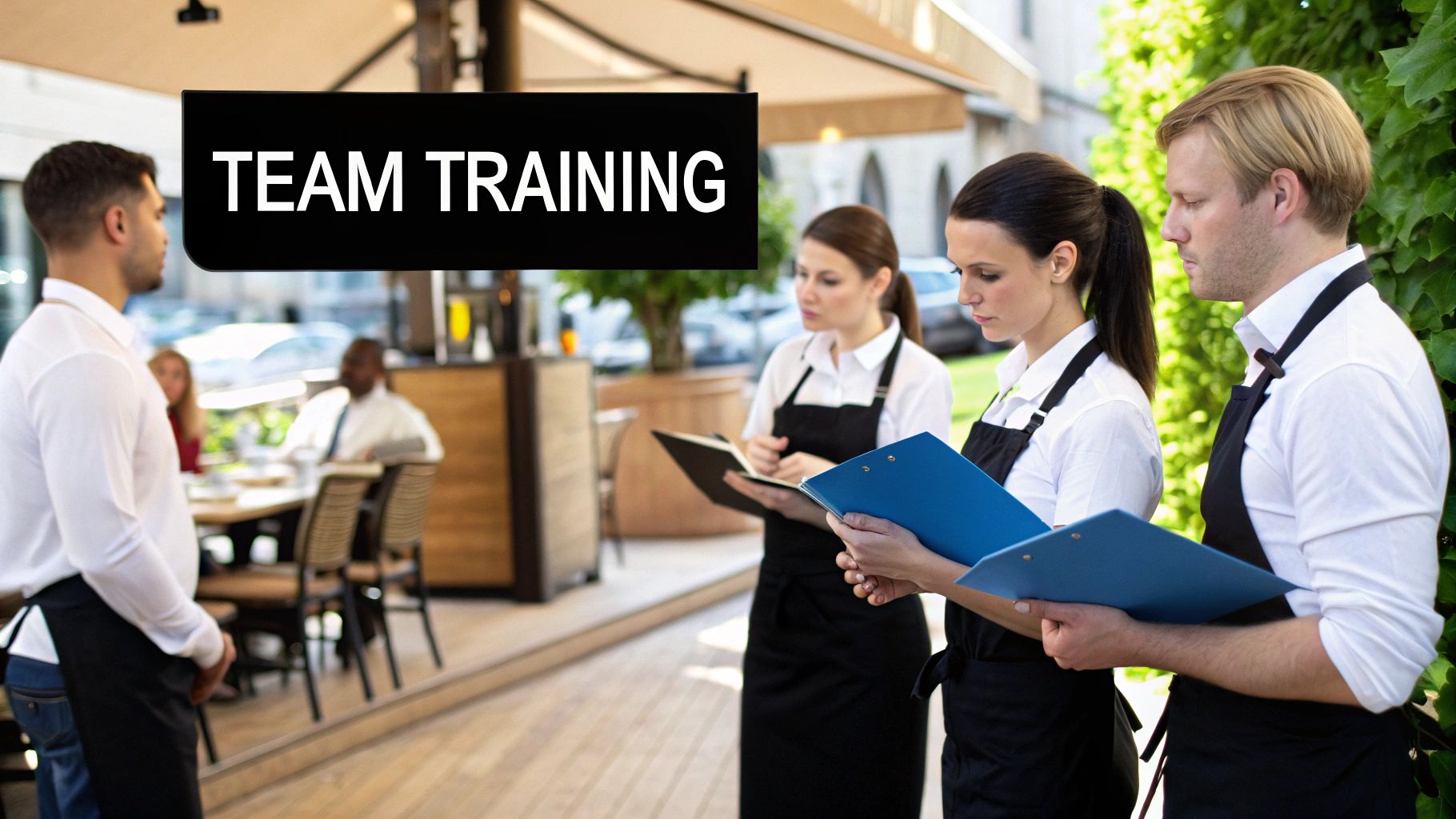
This process balances what you want to cook with what you can execute consistently and what your target market will pay for. For instance, Taco Bell’s famously limited menu is a masterclass in operational efficiency, allowing for rapid service and strict cost control. On the other end of the spectrum, pioneers like Danny Meyer and Thomas Keller demonstrate how meticulously planned menus, whether focused on seasonal ingredients or technical precision, can build a world-class reputation and justify premium pricing.
Key Elements of Menu Engineering:
- Recipe Costing: Calculating the exact cost of every ingredient in every dish. This is the foundation for setting profitable prices.
- Signature Dishes: Developing unique, memorable items that define your restaurant and create a reason for customers to return.
- Operational Feasibility: Ensuring your kitchen staff and equipment can handle the preparation of every menu item efficiently, even during peak hours.
- Supplier Sourcing: Establishing relationships with reliable suppliers who can provide consistent, quality ingredients at a stable price.
- Menu Design & Layout: Strategically using layout, descriptions, and visual cues to guide customers toward high-profitability items.
Actionable Tips for a Profitable Menu:
A successful menu is engineered, not just written. Use these strategies to build a powerful and profitable menu from day one.
- Aim for the "Sweet Spot": Calculate your food costs for each item to achieve a target food cost percentage, generally between 28-32% for most full-service restaurants.
- Conduct Test Tastings: Before finalizing the menu, run tasting sessions with a sample of your target demographic. Gather honest feedback on flavor, portion size, and perceived value.
- Design for Profit: Work with a graphic designer to create a menu layout that uses "golden triangle" principles, placing your most profitable items where a customer's eyes land first (typically the top right corner).
- Plan for Every Guest: Incorporate appealing options for common dietary restrictions like vegetarian, vegan, gluten-free, and nut allergies. Clearly labeling these items can significantly enhance the guest experience. Staying informed on industry news and trends will help you anticipate these needs and find the right restaurant supplies to cater to them effectively.
4. Staff Recruitment and Training Program
Your restaurant concept can be flawless and your menu inspired, but without a skilled and motivated team, it will never reach its full potential. Building a robust staff recruitment and training program is where your brand's promise translates into the guest experience. This is not merely about filling positions; it's about cultivating a culture of excellence and hospitality from day one. A well-structured program ensures consistency, reduces costly turnover, and empowers your team to become your greatest asset. Including this in your checklist for restaurant opening is essential for creating a sustainable business built on quality service.
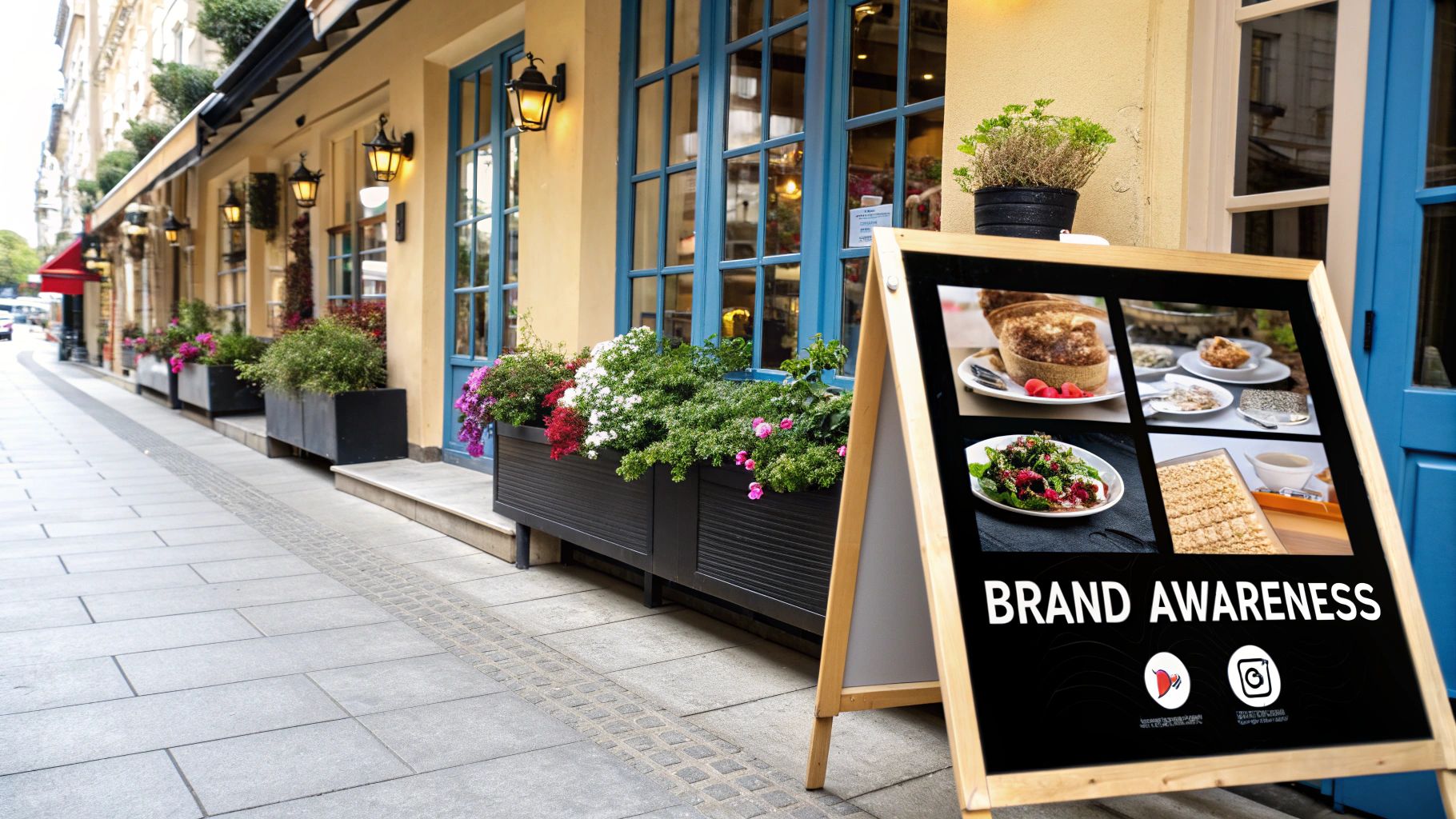
This process involves creating a systematic approach to finding, hiring, onboarding, and continuously developing talent for every role, from the kitchen porter to the general manager. Icons like Danny Meyer have built empires on the principle of "enlightened hospitality," prioritizing employee happiness to drive customer satisfaction. Similarly, In-N-Out Burger's legendary employee loyalty stems from its comprehensive internal training and promotion system, proving that investing in people yields powerful returns in both operational efficiency and brand reputation.
Key Components of a Strong Program:
- Detailed Job Descriptions: Clearly outline the responsibilities, required skills, and expectations for each position (e.g., line cook, server, host, bartender).
- Structured Interview Process: Develop a consistent set of questions and practical assessments to evaluate candidates' skills, experience, and cultural fit.
- Comprehensive Training Manuals: Create detailed guides for each role covering everything from specific recipes and service steps to health codes and POS system operation.
- Onboarding Checklists: Ensure every new hire completes all necessary paperwork, receives uniform and equipment, and is introduced to key team members and policies.
- Ongoing Development Plan: Outline opportunities for advancement, cross-training, and skill enhancement to foster career growth and retention.
Actionable Tips for a Smooth Process:
A proactive and organized approach to staffing will set your restaurant up for a successful launch and long-term stability.
- Start Recruiting Early: Begin your hiring efforts 6 to 8 weeks before your planned opening. This provides ample time for interviews, background checks, and thorough training.
- Offer Competitive Compensation: Research local market rates and offer competitive wages and benefits to attract and retain top-tier talent in a tight labor market.
- Create Role-Specific Checklists: Develop detailed training checklists for every position. A server's checklist might include menu memorization and steps of service, while a cook's covers station setup and recipe execution.
- Implement a Mentorship System: Pair new hires with experienced, high-performing staff members. This "buddy system" provides immediate support, accelerates learning, and helps integrate newcomers into the team culture.
5. Supply Chain and Vendor Management
Your restaurant is only as good as the ingredients you use, making your supply chain the lifeblood of your kitchen. Establishing reliable relationships with food suppliers, beverage distributors, and service vendors is a crucial step in ensuring consistent quality, competitive pricing, and dependable operations. A weak supply chain can lead to inconsistent dishes, unexpected stockouts, and volatile costs that cripple your budget. A well-managed supply chain is an essential part of your checklist for restaurant opening, guaranteeing the quality and availability your customers will come to expect.
This process goes beyond just placing orders; it involves strategic sourcing, negotiation, and relationship management. Consider the pioneering farm-to-table approach of Alice Waters at Chez Panisse, which built a network of local farmers to source the freshest seasonal ingredients, defining the restaurant's entire brand. Similarly, Chipotle’s "Food with Integrity" philosophy relies on a meticulously vetted supply chain of responsibly sourced ingredients, a core element of its marketing and customer appeal. These examples show how a thoughtful supply chain becomes a competitive advantage.
Key Vendor Relationships to Establish:
- Food Suppliers: This includes broadline distributors for dry goods and specialty suppliers for produce, meat, seafood, and dairy.
- Beverage Distributors: For everything from soft drinks and coffee to beer, wine, and spirits, often involving different vendors for each category.
- Linen and Uniform Service: A company to provide and launder your aprons, tablecloths, and staff uniforms.
- Waste Management and Pest Control: Essential services for maintaining a clean and hygienic environment compliant with health codes.
- Point of Sale (POS) and Technology Vendors: Your technology partners for payment processing, online ordering, and reservation systems.
Actionable Tips for a Smooth Process:
Successfully managing your vendors from day one requires a strategic and organized approach. Use these tips to build a resilient supply chain.
- Diversify Your Suppliers: Never rely on a single source for a critical ingredient. Establish relationships with at least one primary and one backup supplier to protect yourself from shortages or sudden price hikes.
- Negotiate Favorable Terms: Don't just accept list price. Negotiate payment terms (e.g., Net 30) that support your cash flow, ask about volume discounts, and clarify delivery schedules and minimum order requirements.
- Implement Strict Receiving Procedures: Train your staff to inspect every delivery for quality, quantity, and temperature. Create detailed product specification sheets so they know exactly what to accept or reject. Effective receiving relies on having the right infrastructure; you can find helpful advice on how to organize your space by reviewing guides on commercial kitchen storage solutions.
- Build Personal Relationships: Get to know your sales representatives. A strong personal connection can lead to better deals, exclusive news on upcoming specials, and more responsive service when you have an urgent need. These relationships are your safety net in a fast-paced industry.
6. Marketing and Brand Development
Building a restaurant is only half the battle; getting customers through the door is the other. A robust marketing and brand development strategy is the engine that drives awareness, attracts your target audience, and establishes a strong market presence long before your grand opening. It’s about creating a narrative, a personality, and a connection that turns first-time visitors into loyal advocates. This is a non-negotiable part of any checklist for restaurant opening, as even the best food can't sell itself in a crowded market.
This process involves a blend of digital and traditional tactics designed to build anticipation and momentum. From defining your brand's unique voice to executing a multi-channel launch campaign, every step should be intentional. For instance, Shake Shack’s mastery of social media and community-centric events creates a cult-like following before a new location even opens. Similarly, local restaurants can achieve tremendous success by partnering with food bloggers and influencers to generate authentic, pre-launch buzz that resonates with the community.
Key Marketing Components You'll Need:
- Brand Identity Kit: This includes your logo, color palette, typography, and brand voice guidelines to ensure consistency across all platforms.
- Website and Online Ordering: Your digital storefront. It should be mobile-friendly, feature your menu, tell your story, and ideally, integrate with an online ordering system.
- Social Media Profiles: Secure your brand handles on key platforms like Instagram, Facebook, and TikTok. Start posting content that showcases your concept, construction progress, and menu teasers.
- Email Marketing Platform: A tool to build and nurture a list of potential customers with updates, pre-opening offers, and news about your grand opening.
- Public Relations (PR) Plan: A strategy for outreach to local media, food critics, and influencers to secure press coverage and reviews.
Actionable Tips for a Powerful Launch:
Successfully launching your brand requires a strategic and proactive approach. Use these tips to build a strong foundation.
- Start Early: Begin marketing efforts at least 3 months before your opening day. This builds anticipation and ensures you have an audience waiting for you.
- Focus on Digital: Prioritize digital marketing for its cost-effectiveness and reach. Use high-quality photos and videos of your food and space to create shareable content.
- Engage Local Influencers: Identify and collaborate with local food bloggers and social media influencers. An invitation to a pre-opening tasting can generate powerful, authentic promotion.
- Plan a Memorable Grand Opening: Create an event that generates buzz. Offer special promotions, live music, or a charity partnership to draw a crowd and media attention. This is your moment to make a strong first impression on patrons and stay informed about industry news and trends.
7. Financial Management and POS Systems
Robust financial management is the central nervous system of your restaurant, and a modern Point-of-Sale (POS) system is its brain. This critical phase involves selecting and implementing the technology and procedures to track every dollar, manage expenses, and process transactions efficiently. Neglecting this area can lead to cash flow problems, inventory discrepancies, and ultimately, business failure. A well-integrated financial system is a non-negotiable part of your checklist for restaurant opening, providing the data you need to make smart, profitable decisions.
This process goes beyond just having a cash register; it's about creating an ecosystem where sales data, inventory levels, and accounting software communicate seamlessly. For instance, many successful independent restaurants have adopted Toast, a POS system built specifically for the foodservice industry, which combines payment processing, online ordering, and employee management into one platform. Similarly, Square offers a suite of tools that allows even small cafes or food trucks to access sophisticated sales analytics and customer relationship management features, proving that powerful financial oversight is accessible to all business sizes.
Key Components of Your Financial System:
- Restaurant-Specific POS System: The hub for all transactions. It should handle order entry, payment processing, table management, and staff timekeeping.
- Payment Processor: The service that securely handles credit and debit card transactions. This is often integrated directly into the POS system.
- Accounting Software: Tools like QuickBooks or Xero to manage your chart of accounts, track expenses, handle payroll, and generate financial statements.
- Inventory Management Software: Often a module within the POS, this tracks stock levels, calculates food costs, and helps manage supplier orders.
- Cash Handling Procedures: A clearly defined set of rules for managing cash drawers, performing daily reconciliations, and making bank deposits to prevent theft and errors.
Actionable Tips for a Smooth Process:
Implementing your financial tech stack requires careful planning and a focus on integration. Use these strategies to build a solid foundation.
- Choose a Restaurant-Focused POS: Select a system designed for the unique workflow of a restaurant, not a generic retail POS. Look for features like menu modifiers, table mapping, and kitchen display system (KDS) integration.
- Prioritize Integration: Ensure your POS system can sync directly with your accounting and inventory software. This automation saves countless hours and reduces the risk of manual data entry errors.
- Train Staff Thoroughly: All front-of-house and management staff must be experts in using the POS. Conduct comprehensive training on order entry, payment splitting, applying discounts, and end-of-shift reporting.
- Establish Strong Internal Controls: Implement strict cash handling protocols, such as requiring manager approval for voids and comps. Regularly audit sales reports and cash deposits to identify discrepancies quickly. Plan for redundancy with backup internet and offline payment processing options to discover the latest news and industry trends on technology solutions.
7-Point Restaurant Opening Checklist Comparison
| Aspect | Legal Compliance and Permits | Kitchen Equipment and Layout Design | Menu Development and Pricing Strategy | Staff Recruitment and Training Program | Supply Chain and Vendor Management | Marketing and Brand Development | Financial Management and POS Systems |
|---|---|---|---|---|---|---|---|
| Implementation Complexity 🔄 | High due to complex regulations and location variance | High; involves design, installation, and setup | Medium; recipe testing and pricing analysis | Medium; recruitment plus comprehensive training | Medium; contract negotiation and relationship management | Medium; strategic planning and execution | Medium; tech integration and staff training |
| Resource Requirements ⚡ | Moderate; legal expertise and application fees | High; costly equipment and professional design | Moderate; culinary staff and ingredient costs | Moderate; HR resources and training materials | Variable; buying power and supplier diversity | Moderate; marketing budget and creative resources | Moderate; POS hardware/software and training |
| Expected Outcomes 📊 | ⭐⭐ Legal protection, permits, and compliance | ⭐⭐⭐ Optimized workflow and food safety | ⭐⭐ Balanced menu profitability and appeal | ⭐⭐ Consistent service and reduced turnover | ⭐⭐ Reliable supply and quality control | ⭐⭐ Brand awareness and customer traffic | ⭐⭐ Real-time financial control and streamlined ops |
| Ideal Use Cases 💡 | Opening new locations; required for legal ops | Establishing or upgrading commercial kitchens | New restaurant concepts or menu revamps | Launching new venues or scaling service teams | Managing multiple suppliers or ensuring quality | New restaurants needing strong market entry | Restaurants needing financial oversight & tech |
| Key Advantages ⭐ | Legal legitimacy, customer trust, vendor access | Efficiency, safety compliance, lower labor costs | Cost control, consistent quality, marketing support | Quality staff, training consistency, culture | Consistent inventory, cost savings, supplier fallback | Builds customer base, loyalty, and differentiation | Data-driven insights, error reduction, compliance |
Your Partner in Culinary Success: Beyond the Checklist
Completing this comprehensive checklist for restaurant opening is a monumental achievement. You have navigated the intricate maze of legal permits, meticulously designed your kitchen layout, engineered a profitable menu, and assembled a team ready to bring your culinary vision to life. From establishing robust supply chains to launching a compelling brand, you have laid the essential groundwork for a successful launch. Consider this checklist your launchpad, not the finish line. The real journey, the dynamic and ever-evolving adventure of running a restaurant, is just beginning.
The initial steps are foundational, but long-term success in this competitive industry hinges on your ability to adapt, learn, and continuously refine your operations. The restaurant world does not stand still. Customer tastes shift, new technologies emerge, and economic currents can change overnight. The strategies that work on opening day will need to evolve.
From Blueprint to Breathing Operation: Key Takeaways
As you transition from planning to operating, keep these core principles at the forefront. They are the threads that connect every item on your checklist and will guide your decisions long after the "Grand Opening" banner comes down.
-
Agility is Your Greatest Asset: Your business plan is a guide, not a rigid set of rules. Be prepared to pivot. If a menu item isn't selling, analyze why and be willing to change it. If a marketing channel isn't delivering results, reallocate your budget. The ability to respond quickly to feedback and data is what separates thriving restaurants from those that falter.
-
Your Team is Your Brand: Your staff are the living, breathing embodiment of your restaurant's brand. Comprehensive training is not a one-time event; it is an ongoing commitment. Invest in their growth, listen to their feedback from the front lines, and cultivate a positive culture. A happy, well-trained team delivers the exceptional service that creates loyal customers.
-
Financial Diligence is Non-Negotiable: Passion fuels a restaurant, but cash flow keeps it running. Maintain a disciplined approach to your finances. Regularly review your prime costs (food, beverage, and labor), analyze your POS data to understand sales trends, and always maintain a cash reserve for unexpected expenses. Financial clarity is the bedrock of sustainable growth.
The Next Chapter: Continuous Improvement and Strategic Partnerships
The most successful restaurateurs are perpetual students of the industry. Your grand opening is merely the first day of a lifelong education in hospitality. To stay ahead, you must actively seek out knowledge and forge the right partnerships.
Key Insight: Your relationship with your suppliers should be a strategic partnership, not just a series of transactions. A great supplier acts as an extension of your team, providing industry intelligence, innovative solutions, and support that goes beyond the invoice.
Staying informed is critical. Make it a weekly habit to read industry publications and follow thought leaders. Keep a close eye on emerging trends in:
- Equipment and Technology: New combi ovens that save energy, smarter POS systems that offer deeper analytics, or innovative food preservation tools can significantly impact your bottom line and operational efficiency.
- Supply Chain Innovations: Stay aware of new local farm partners, sustainable sourcing options, and shifts in commodity pricing that could affect your menu costs.
- Marketing and Guest Experience: Digital ordering, loyalty programs, and social media engagement tactics are constantly evolving. What works today might be outdated in six months.
This is where a knowledgeable partner becomes invaluable. A top-tier equipment and supply vendor does more than just sell you a refrigerator. They help you stay informed about industry trends, alert you to exclusive deals on supplies, and introduce you to groundbreaking equipment. They can even offer flexible financing options to help you acquire the tools you need to scale without crippling your cash flow.
Embrace this journey with confidence. You have diligently worked through the checklist for restaurant opening, and you possess the plan and the passion to succeed. Now, couple that with a commitment to continuous learning and strategic collaboration. Welcome to the industry. Your exciting, challenging, and rewarding culinary adventure has truly begun.
Ready to equip your new kitchen or upgrade your existing one with a partner who understands your journey? Encore Seattle Restaurant Equipment offers a vast selection of new and used equipment, expert layout advice, and the industry insights you need to make smart investments. Explore our inventory and see how we can help bring your restaurant vision to life at Encore Seattle Restaurant Equipment.
